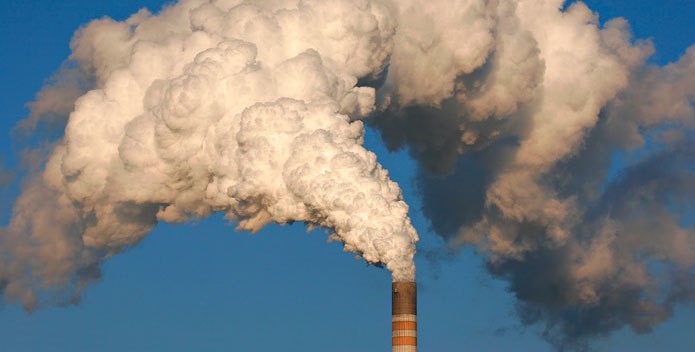NOVEMBER UPDATE: EPA chief Scott Pruitt has recently signed a measure to rescind the Clean Power Plan, former EPA Administrator Gina McCarthy's 2015 plan to reduce greenhouse gas emissions from coal-fired power plants, without proposing a substitute rule. Rescinding the Clean Power Plan could have lasting implications on the health of the Chesapeake Bay and the success of the Chesapeake Clean Water Blueprint.
The Clean Power Plan ("CPP") is a vital component for clean air in the Chesapeake Bay watershed. The regulations in the CPP are designed to curb the emission of greenhouse gases (carbon dioxide, nitrogen oxides (NOx), methane, and hydrofluorocarbons). These pollutants are emitted in massive quantities by coal-fired power plants and have led to the warming of our planet causing acidification of ocean water, climate change, and sea level rise.
Sea level rise causes flooding and destruction of wetlands or "sponges" for nutrients like nitrogen in polluted runoff. Some of these pollutants directly cause adverse health conditions for children, the elderly and those with chronic asthma and bronchitis.
Ignoring the impacts of climate change is short-sighted and will damage the health of the Chesapeake Bay. Acidification of the Bay will harm oysters and other shellfish. The Bay's trophy rockfish are struggling to find oxygen as the water gets hotter. Warmer waters stress species like soft shelled clams and eelgrass, potentially eliminating them entirely from the Chesapeake Bay. Sea-level rise is threatening low-lying lands like Tangier Island and flooding coastal marshes essential for the retention of polluted runoff and excess nutrients like nitrogen.
In addition to reducing the impacts of climate change and to human health, implementation of the CPP would help meet nitrogen reductions, a key to the success of the Chesapeake Clean Water Blueprint. Nitrogen from air pollution (fossil fuel combustion—NOx and livestock manure—ammonia) is the largest source of nitrogen pollution to the Chesapeake Bay. Without sufficient air pollution control regulations, like the CPP, it will be extremely difficult for EPA and the states to meet the reductions set forth in the Blueprint to restore the Bay and its rivers and streams.
The air pollution reductions we would get from the Clean Power Plan would go a long way to improving the health of people living in the Bay Region—including children, the elderly, and the poor—as well as meeting the nitrogen reductions set in the Chesapeake Clean Water Blueprint to restore the Bay and its rivers and streams. Take a look at our blog below from earlier this year, documenting the origins of the Clean Power Plan and how its rollback could threaten Chesapeake restoration:
What happened?
In 2005, despite the significant body of scientific evidence showing a correlation between increased carbon dioxide concentrations in the atmosphere and increasing global temperatures, EPA refused to develop regulations curbing the emission of greenhouse gases like carbon dioxide from power plants, cars, and trucks.
Because of growing concern over climate change and sea level rise, several states, local governments, and private organizations brought a lawsuit to require EPA to create regulations designed to curb the emission of greenhouse gases (carbon dioxide, nitrogen oxides, methane, and hydrofluorocarbons). In 2007, the Supreme Court held that given the clear scientific evidence for human-caused climate change and the potential for adverse human health impacts, EPA had the authority under the Clean Air Act to regulate greenhouse gases. Click here to learn more about Massachusetts v. EPA, 549 U.S. 497 (2007).
Following the Supreme Court's direction, on August 3, 2015, EPA issued a new regulation under the Clean Air Act called the Clean Power Plan for Existing Power Plants ("The Plan").
Several types of power plants (coal, nuclear, gas, oil, hydroelectric) generate electricity for our homes and businesses. The Plan focuses on coal-burning power plants. Several lawsuits have been filed against EPA challenging the Plan. Those lawsuits are still pending.
Now, President Trump has signaled that he wants to revoke the Plan. That could be attempted in several different ways, but all would require that the public be given notice of and the ability to comment on EPA's change in position. Citizens, states, or industry could later sue the government if they believed the agency's decision was arbitrary, capricious, or illegal.
How could elimination of the Clean Power Plan affect Bay restoration?
The Plan gives states three ways to reduce carbon dioxide emissions from coal-fired power plants within their borders. The most effective way would be to make the power plants more efficient in generating electricity; that is, make them burn less fuel to generate the same amount of electricity. Making these plants more fuel efficient or even shutting them down would mean the plants would emit less nitrogen oxides (NOx). Because NOx is a major source of nitrogen pollution to the Bay, implementation of the Power Plan would greatly improve Bay health. (See Bay TMDL, Appendix L and Eshleman, K., et al., "Declining nitrate-N yields in the Upper Potomac River Basin: What is really driving progress under Chesapeake Bay restoration?")
Once EPA decides to act, it is expected to tell the courts considering the Plan that it wants to reevaluate the rule so all litigation should be suspended. Then, it is likely that the agency will issue a new rule either reversing the earlier finding that greenhouse gases from power plants are causing climate change that is harming humans or revising the rule significantly to weaken its impact on coal-fired power plants. If the Trump Administration takes such action, it is expected that some states and private groups will sue EPA. A protracted legal fight is expected.
CBF's legal and policy teams are monitoring EPA's actions with respect to the Clean Power Plan and will take the appropriate actions if required to preserve the Chesapeake Clean Water Blueprint and ensure Bay restoration moves forward.
Click here to learn about what you can do right now to support clean water across our region.



